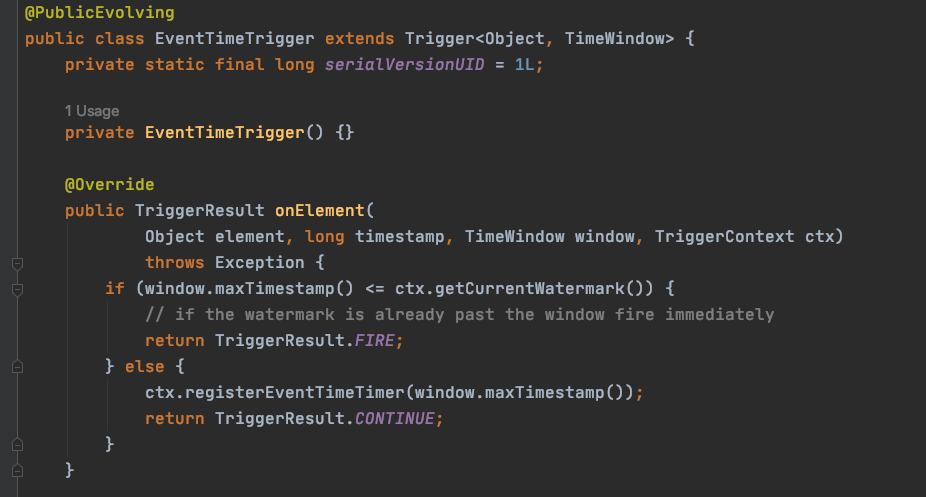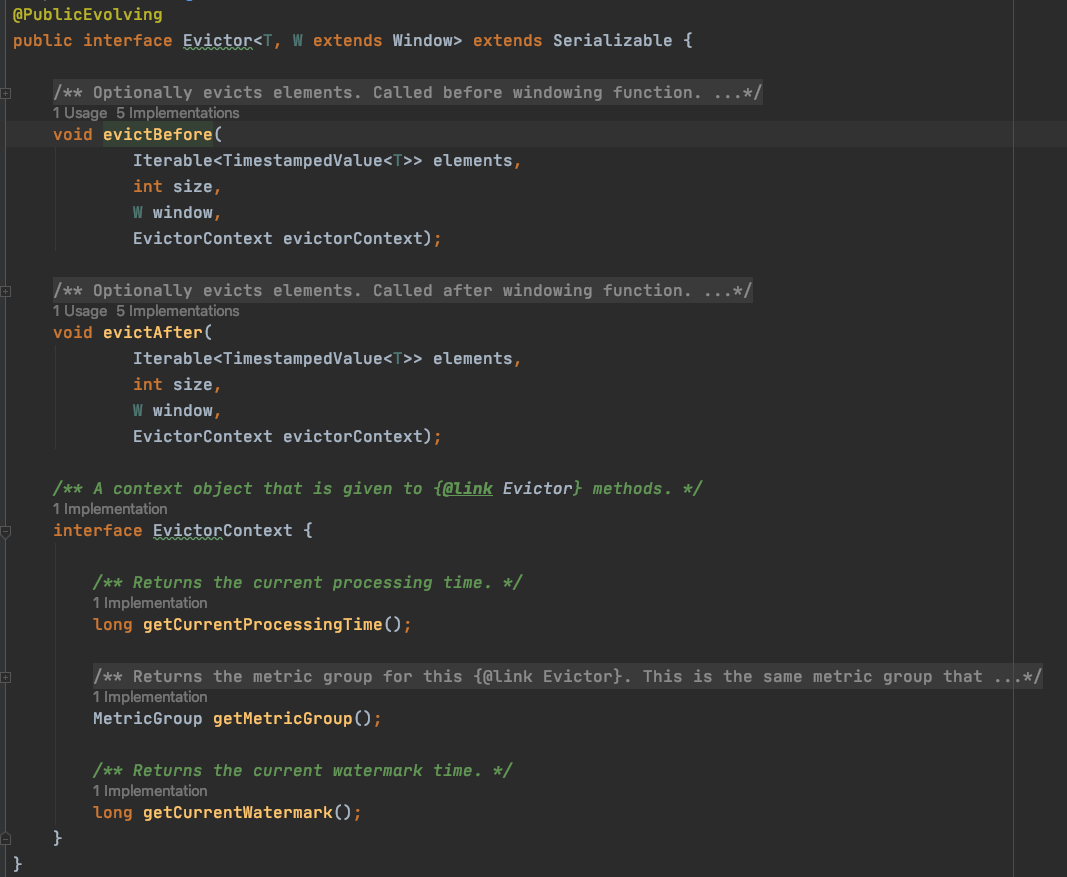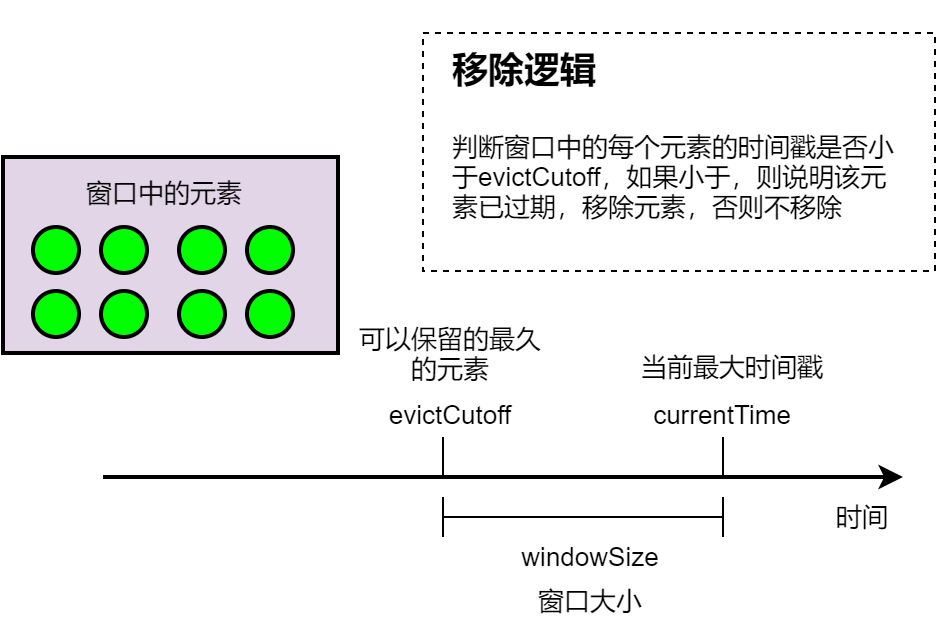聊聊Flink:这次把Flink的触发器(Trigger)、移除器(Evictor)讲透
一、触发器(Trigger)
Trigger 决定了一个窗口(由 window assigner 定义)何时可以被 window function 处理。每个 WindowAssigner 都有一个默认的 Trigger。如果默认 trigger 无法满足你的需要,你可以在 trigger(…) 调用中指定自定义的 trigger。
1.1 Flink中预置的Trigger
窗口的计算触发依赖于窗口触发器,每种类型的窗口都有对应的窗口触发机制,都有一个默认的窗口触发器,触发器的作用就是去控制什么时候来触发计算。flink内部定义多种触发器,每种触发器对应于不同的WindowAssigner。常见的触发器如下:
EventTimeTrigger:通过对比EventTime和窗口的Endtime确定是否触发窗口计算,如果EventTime大于Window EndTime则触发,否则不触发,窗口将继续等待。
ProcessTimeTrigger:通过对比ProcessTime和窗口EndTme确定是否触发窗口,如果ProcessTime大于EndTime则触发计算,否则窗口继续等待。
ProcessingTimeoutTrigger:可以将任何触发器转变为超时触发器。
ContinuousEventTimeTrigger:根据间隔时间周期性触发窗口或者Window的结束时间小于当前EndTime触发窗口计算。
ContinuousProcessingTimeTrigger:根据间隔时间周期性触发窗口或者Window的结束时间小于当前ProcessTime触发窗口计算。
CountTrigger:根据接入数据量是否超过设定的阙值判断是否触发窗口计算。
DeltaTrigger:根据接入数据计算出来的Delta指标是否超过指定的Threshold去判断是否触发窗口计算。
PurgingTrigger:可以将任意触发器作为参数转换为Purge类型的触发器,计算完成后数据将被清理。
NeverTrigger:任何时候都不触发窗口计算
1.2 Trigger的抽象类
Trigger 接口提供了五个方法来响应不同的事件:
onElement() 方法在每个元素被加入窗口时调用。
onEventTime() 方法在注册的 event-time timer 触发时调用。
onProcessingTime() 方法在注册的 processing-time timer 触发时调用。
canMerge() 方法判断是否可以合并。
onMerge() 方法与有状态的 trigger 相关。该方法会在两个窗口合并时, 将窗口对应 trigger 的状态进行合并,比如使用会话窗口时。
clear() 方法处理在对应窗口被移除时所需的逻辑。
触发器接口的源码如下:
@PublicEvolving
public abstract class Trigger<T, W extends Window> implements Serializable {
private static final long serialVersionUID = -4104633972991191369L;
/**
* Called for every element that gets added to a pane. The result of this will determine whether
* the pane is evaluated to emit results.
*
* @param element The element that arrived.
* @param timestamp The timestamp of the element that arrived.
* @param window The window to which the element is being added.
* @param ctx A context object that can be used to register timer callbacks.
*/
public abstract TriggerResult onElement(T element, long timestamp, W window, TriggerContext ctx)
throws Exception;
/**
* Called when a processing-time timer that was set using the trigger context fires.
*
* @param time The timestamp at which the timer fired.
* @param window The window for which the timer fired.
* @param ctx A context object that can be used to register timer callbacks.
*/
public abstract TriggerResult onProcessingTime(long time, W window, TriggerContext ctx)
throws Exception;
/**
* Called when an event-time timer that was set using the trigger context fires.
*
* @param time The timestamp at which the timer fired.
* @param window The window for which the timer fired.
* @param ctx A context object that can be used to register timer callbacks.
*/
public abstract TriggerResult onEventTime(long time, W window, TriggerContext ctx)
throws Exception;
/**
* Returns true if this trigger supports merging of trigger state and can therefore be used with
* a {@link org.apache.flink.streaming.api.windowing.assigners.MergingWindowAssigner}.
*
* <p>If this returns {@code true} you must properly implement {@link #onMerge(Window,
* OnMergeContext)}
*/
public boolean canMerge() {
return false;
}
/**
* Called when several windows have been merged into one window by the {@link
* org.apache.flink.streaming.api.windowing.assigners.WindowAssigner}.
*
* @param window The new window that results from the merge.
* @param ctx A context object that can be used to register timer callbacks and access state.
*/
public void onMerge(W window, OnMergeContext ctx) throws Exception {
throw new UnsupportedOperationException("This trigger does not support merging.");
}
/**
* Clears any state that the trigger might still hold for the given window. This is called when
* a window is purged. Timers set using {@link TriggerContext#registerEventTimeTimer(long)} and
* {@link TriggerContext#registerProcessingTimeTimer(long)} should be deleted here as well as
* state acquired using {@link TriggerContext#getPartitionedState(StateDescriptor)}.
*/
public abstract void clear(W window, TriggerContext ctx) throws Exception;
// ------------------------------------------------------------------------
/**
* A context object that is given to {@link Trigger} methods to allow them to register timer
* callbacks and deal with state.
*/
public interface TriggerContext {
// ...
}
/**
* Extension of {@link TriggerContext} that is given to {@link Trigger#onMerge(Window,
* OnMergeContext)}.
*/
public interface OnMergeContext extends TriggerContext {
<S extends MergingState<?, ?>> void mergePartitionedState(
StateDescriptor<S, ?> stateDescriptor);
}
}
关于上述方法,需要注意三件事:
(1)前三个方法返回TriggerResult枚举类型,其包含四个枚举值:
CONTINUE:表示对窗口不执行任何操作。即不触发窗口计算,也不删除元素。
FIRE:触发窗口计算,但是保留窗口元素。
PURGE:不触发窗口计算,丢弃窗口,并且删除窗口的元素。
FIRE_AND_PURGE:触发窗口计算,输出结果,然后将窗口中的数据和窗口进行清除。
源码如下:
public enum TriggerResult {
// 不触发,也不删除元素
CONTINUE(false, false),
// 触发窗口,窗口出发后删除窗口中的元素
FIRE_AND_PURGE(true, true),
// 触发窗口,但是保留窗口元素
FIRE(true, false),
// 不触发窗口,丢弃窗口,并且删除窗口的元素
PURGE(false, true);
// ------------------------------------------------------------------------
private final boolean fire;
private final boolean purge;
TriggerResult(boolean fire, boolean purge) {
this.purge = purge;
this.fire = fire;
}
public boolean isFire() {
return fire;
}
public boolean isPurge() {
return purge;
}
}
(2) 每一个窗口分配器都拥有一个属于自己的 Trigger,Trigger上会有定时器,用来决定一个窗口何时能够被计算或清除,当定时器触发后,会调用对应的回调返回,返回TriggerResult。Trigger的返回结果可以是 continue(不做任何操作),fire(处理窗口数据),purge(移除窗口和窗口中的数据),或者 fire + purge。一个Trigger的调用结果只是fire的话,那么会计算窗口并保留窗口原样,也就是说窗口中的数据仍然保留不变,等待下次Trigger fire的时候再次执行计算。一个窗口可以被重复计算多次知道它被 purge 了。在purge之前,窗口会一直占用着内存。
1.3 ProcessingTimeTrigger源码分析
@PublicEvolving
public class ProcessingTimeTrigger extends Trigger<Object, TimeWindow> {
private static final long serialVersionUID = 1L;
private ProcessingTimeTrigger() {}
@Override
public TriggerResult onElement(
Object element, long timestamp, TimeWindow window, TriggerContext ctx) {
ctx.registerProcessingTimeTimer(window.maxTimestamp());
return TriggerResult.CONTINUE;
}
@Override
public TriggerResult onEventTime(long time, TimeWindow window, TriggerContext ctx)
throws Exception {
return TriggerResult.CONTINUE;
}
@Override
public TriggerResult onProcessingTime(long time, TimeWindow window, TriggerContext ctx) {
return TriggerResult.FIRE;
}
@Override
public void clear(TimeWindow window, TriggerContext ctx) throws Exception {
ctx.deleteProcessingTimeTimer(window.maxTimestamp());
}
@Override
public boolean canMerge() {
return true;
}
@Override
public void onMerge(TimeWindow window, OnMergeContext ctx) {
// only register a timer if the time is not yet past the end of the merged window
// this is in line with the logic in onElement(). If the time is past the end of
// the window onElement() will fire and setting a timer here would fire the window twice.
long windowMaxTimestamp = window.maxTimestamp();
if (windowMaxTimestamp > ctx.getCurrentProcessingTime()) {
ctx.registerProcessingTimeTimer(windowMaxTimestamp);
}
}
@Override
public String toString() {
return "ProcessingTimeTrigger()";
}
/** Creates a new trigger that fires once system time passes the end of the window. */
public static ProcessingTimeTrigger create() {
return new ProcessingTimeTrigger();
}
}
在 onElement()方法中,ctx.registerProcessingTimeTimer(window.maxTimestamp())将会注册一个ProcessingTime定时器,时间参数是window.maxTimestamp(),也就是窗口的最终时间,当时间到达这个窗口最终时间,定时器触发并调用 onProcessingTime()方法,在 onProcessingTime() 方法中,return TriggerResult.FIRE 即返回 FIRE,触发窗口中数据的计算,但是会保留窗口元素。
需要注意的是ProcessingTimeTrigger类只会在窗口的最终时间到达的时候触发窗口函数的计算,计算完成后并不会清除窗口中的数据,这些数据存储在内存中,除非调用PURGE或FIRE_AND_PURGE,否则数据将一直存在内存中。实际上,Flink中提供的Trigger类,除了PurgingTrigger类,其他的都不会对窗口中的数据进行清除。
EventTimeTriggerr在onElement设置的定时器:

EventTime通过registerEventTimeTimer注册定时器,在内部Watermark达到或超过Timer设定的时间戳时触发。
二、移除器(Evictor)
2.1 Evictor扮演的角色

当一个元素进入stream中之后,一般要经历Window(开窗)、Trigger(触发器)、Evitor(移除器)、Windowfunction(窗口计算操作),具体过程如下:
Window中的WindowAssigner(窗口分配器)定义了数据应该被分配到哪个窗口中,每一个 WindowAssigner都会有一个默认的Trigger,如果用户在代码中指定了窗口的trigger,默认的 trigger 将会被覆盖。
Trigger上会有定时器,用来决定一个窗口何时能够被计算或清除。Trigger的返回结果可以是 continue(不做任何操作),fire(处理窗口数据),purge(移除窗口和窗口中的数据),或者 fire + purge。一个Trigger的调用结果只是fire的话,那么会计算窗口并保留窗口原样,也就是说窗口中的数据仍然保留不变,等待下次Trigger fire的时候再次执行计算。一个窗口可以被重复计算多次知道它被 purge 了。在purge之前,窗口会一直占用着内存。
当Trigger fire了,窗口中的元素集合就会交给Evictor(如果指定了的话)。Evictor 主要用来遍历窗口中的元素列表,并决定最先进入窗口的多少个元素需要被移除。剩余的元素会交给用户指定的函数进行窗口的计算。如果没有 Evictor 的话,窗口中的所有元素会一起交给WindowFunction进行计算。
WindowFunction收到了窗口的元素(可能经过了 Evictor 的过滤),并计算出窗口的结果值,并发送给下游。窗口计算操作有很多,比如预定义的sum(),min(),max(),还有 ReduceFunction,WindowFunction。WindowFunction 是最通用的计算函数,其他的预定义的函数基本都是基于该函数实现的。
现在,大致了解了Evitor(移除器)扮演的角色和移除器在流中的哪个位置,让我们继续看为何使用Evictor。
Evictor接口定义如下:

窗格是具有相同Key和相同窗口的元素组成的桶,即同一个窗口中相同Key的元素一定属于同一个窗格。一个元素可以在多个窗格中(当一个元素被分配给多个窗口时),这些窗格都有自己的清除器实例。
注:window默认没有evictor,一旦把window指定Evictor,该window会由EvictWindowOperator类来负责操作。
2.2 Flink内置的Evitor
CountEvictor:保留窗口中用户指定的元素数量,并丢弃窗口缓冲区剩余的元素。
DeltaEvictor:依次计算窗口缓冲区中的最后一个元素与其余每个元素之间的delta值,若delta值大于等于指定的阈值,则该元素会被移除。使用DeltaEvictor清除器需要指定两个参数,一个是double类型的阈值;另一个是DeltaFunction接口的实例,DeltaFunction用于指定具体的delta值计算逻辑。
TimeEvictor:传入一个以毫秒为单位的时间间隔参数(例如以size表示),对于给定的窗口,取窗口中元素的最大时间戳(例如以max表示),使用TimeEvictor清除器将删除所有时间戳小于或等于max-size的元素(即清除从窗口开头到指定的截止时间之间的元素)。
2.2.1 CountEvictor
private void evict(Iterable<TimestampedValue<Object>> elements, int size, EvictorContext ctx) {
if (size <= maxCount) {
// 小于最大数量,不做处理
return;
} else {
int evictedCount = 0;
for (Iterator<TimestampedValue<Object>> iterator = elements.iterator(); iterator.hasNext();){
iterator.next();
evictedCount++;
if (evictedCount > size - maxCount) {
break;
} else {
// 移除前size - maxCount个元素,只剩下最后maxCount个元素
iterator.remove();
}
}
}
}
2.2.2 DeltaEvictor
DeltaEvictor通过计算DeltaFunction的值(依次传入每个元素和最后一个元素),并将其与threshold进行对比,如果DeltaFunction计算结果大于等于threshold,则该元素会被移除。DeltaEvictor的实现如下:
private void evict(Iterable<TimestampedValue<T>> elements, int size, EvictorContext ctx) {
// 获取最后一个元素
TimestampedValue<T> lastElement = Iterables.getLast(elements);
for (Iterator<TimestampedValue<T>> iterator = elements.iterator(); iterator.hasNext();){
TimestampedValue<T> element = iterator.next();
// 依次计算每个元素和最后一个元素的delta值,同时和threshold的值进行比较
// 若计算结果大于threshold值或者是相等,则该元素会被移除
if (deltaFunction.getDelta(element.getValue(), lastElement.getValue()) >= this.threshold) {
iterator.remove();
}
}
}
2.2.3 TimeEvictor
TimeEvictor以时间为判断标准,决定元素是否会被移除。TimeEvictor会获取窗口中所有元素的最大时间戳currentTime,currentTime减去窗口大小(windowSize) 可得到能保留最久的元素的时间戳evictCutoff,然后再遍历窗口中的元素,如果元素的时间戳小于evictCutoff,就执行移除操作,否则不移除。具体逻辑如下图所示:

TimeEvictor的代码实现如下:
private void evict(Iterable<TimestampedValue<Object>> elements, int size, EvictorContext ctx) {
// 如果element没有timestamp,直接返回
if (!hasTimestamp(elements)) {
return;
}
// 获取elements中最大的时间戳(到来最晚的元素的时间)
long currentTime = getMaxTimestamp(elements);
// 截止时间为: 到来最晚的元素的时间 - 窗口大小(可以理解为保留最近的多久的元素)
long evictCutoff = currentTime - windowSize;
for (Iterator<TimestampedValue<Object>> iterator = elements.iterator(); iterator.hasNext(); ) {
TimestampedValue<Object> record = iterator.next();
// 清除所有时间戳小于截止时间的元素
if (record.getTimestamp() <= evictCutoff) {
iterator.remove();
}
}
}
欢迎大家关注我的公众号【老周聊架构】,AI、大数据、云原生、物联网等相关领域的技术知识分享。
